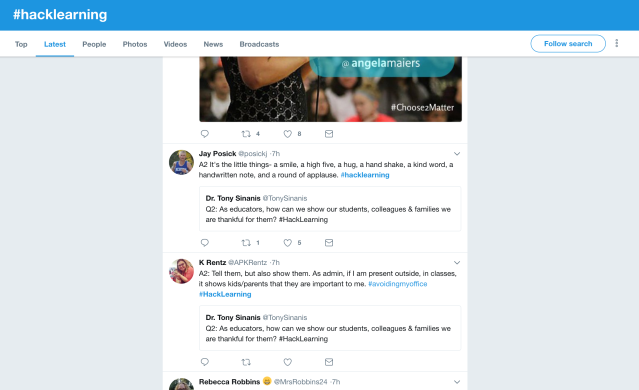At Feaster, we are very fortunate to have weekly collaboration times and I truly believe that maintaining this practice is best for our teachers and our students. It gives us time with our teams to reflect, discuss the how, and take an in-depth look at the outcomes of our lessons by analyzing student work. For our students, these weekly collaborations mean that they are able to experience their Mindlab courses and build skills that may not be integrated into classrooms lessons. All of this is crucial to the success of our learners on campus – both teachers and students.
Within the past year, I have started to recognize the benefit of expanding collaborative practices and building a personal learning network (PLN). A PLN is a way to build relationships with other educators globally and locally. We are developing new practices and continuing existing practices that are very effective. There are so many other schools that are doing just this; however, we have yet to understand what they are doing because we are geographically separated. Even at times on our own campus we can be separated. We have teachers on campus doing amazing things everyday, but we do not know about it because we are in our own classrooms doing amazing things as well.
George Couros spoke at a conference another educator and I attended and he asked the question:
“What if every teacher tweeted one thing a day they did in their classroom to a school hashtag and took 5 minutes a day to read each others’ tweets?
What would that do for learning and school culture?”
@gcouros
I appreciate this quote because it is gives a solution to something that has been a concern for me for far too long. Often, I find myself struggling to reach certain students and after a lesson, I spend hours reflecting on it and thinking about what was successful and what I need to change. I will talk to other educators to learn different strategies, but this is often hard to do during school hours. This quote, if we all work together and make it a reality, solves that problem because it gives teachers a platform to share their learning and hear from others. I appreciate that it includes the idea of not only sharing knowledge but also receiving knowledge – it is crucial to be both a producer and a consumer of quality practices. For a more in depth blog post on this, read, “The Education ‘Bat Signal’ ”
This quote has had a huge impact on my professional learning. I truly understood the positive impact that Twitter and my PLN had on my professional learning while I was at a conference, listening to someone go on about Common Core. I realized that my thinking was not being pushed, so I logged onto Twitter and joined Twitter Chat. A Twitter Chat is an online conversation where the facilitator(s) provide questions and the participants write their responses – see image below for an example. While physically sitting in that conference, I did not learn anything that would incredibly impact my learning from the one speaker. I did, however, learn new strategies from the hundreds of educators participating in the Twitter Chat.

We have been doing so much to develop relationships and we cannot forget our online relationships as well. When we share what we are doing to the hashtag, #FeasterLearns, it helps others learn from our practices, it helps us to guide our conversations during collaboration, and it may even inspire other teachers by giving them different strategies to try. When we are sharing our practices and learning from each other, we are working to develop a deeper appreciation towards others that will benefit all 1,240 of our students instead of just the 20-30 in our classrooms.
Other Resources Related to this Topic:
What if Every Teacher Tweeted?
